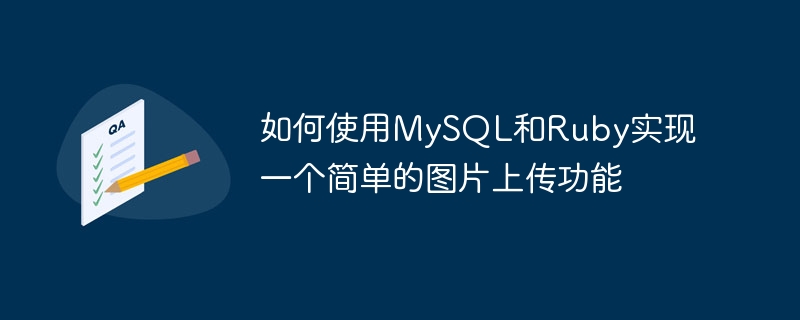

How to use MySQL and Ruby to implement a simple image upload function
Introduction:
The image upload function is one of the very common functions in modern web applications. Through this function, users can upload their own pictures to the server and display or share them when needed. This article will introduce how to use MySQL and Ruby to implement a simple image upload function, and provide specific code examples.
Step 1: Database design
First, we need to create a database table to store the image information uploaded by the user. Using MySQL database, create a table named "pictures", containing the following fields:
Step 2: Create a Ruby application
Create a new Ruby application in the local environment. And add necessary dependent libraries. We will use Sinatra as the web framework, and the associated plugins to handle file uploads.
require 'sinatra'
require 'sinatra/reloader'
configure do
enable :sessions
end
get '/' do
erb :index
end
post '/upload' do
if params[:file]
filename = params[:file][:filename]
file = params[:file][:tempfile]
# 保存文件到服务器上
File.open("./uploads/#{filename}", 'wb') do |f|
f.write(file.read)
end
# 将图片信息保存到数据库
# 在这里使用合适的MySQL库进行数据库操作
"图片上传成功!"
else
"请选择文件"
end
endIn the above code, we created a simple web application using the Sinatra framework. When the user accesses the root path "/", a simple form will be displayed for uploading images. When the user clicks the upload button, the application will obtain the uploaded image file and save it to the specified directory on the server.
Step 3: Process file upload
In the above code, we use Ruby's File library to save the uploaded file to the server. Now, we need to save the image information into the MySQL database.
require 'mysql2'
# 连接到MySQL数据库
client = Mysql2::Client.new(
:host => 'localhost',
:username => 'root',
:password => 'password',
:database => 'my_database'
)
# 将图片信息插入到数据库中
client.query("
INSERT INTO pictures (name, filename, created_at)
VALUES ('#{params[:file][:filename]}', '#{params[:file][:filename]}', NOW())
")The above code connects to a MySQL database named "my_database" through the Mysql2 library, and inserts picture information into the "pictures" table.
Step 4: Display the uploaded images
In order to display the images uploaded by the user, we can create a simple page and obtain all the image information from the database and display it.
get '/pictures' do
# 从数据库中获取所有的图片信息
results = client.query("SELECT * FROM pictures")
# 构建一个HTML列表展示图片
html = "<ul>"
results.each do |row|
html += "<li><img src='/uploads/#{row['filename']}' alt='#{row['name']}'></li>"
end
html += "</ul>"
html
endIn the above code, we obtained all the picture information by querying the database, and used HTML to build a picture list. By accessing the "/pictures" path, we can display all user-uploaded pictures.
Summary:
Through the combination of MySQL and Ruby, we can easily implement a simple image upload function. This article provides specific code examples to help readers get started quickly. It should be noted that the above examples are for reference only. In actual applications, issues such as file upload security, database connection, and error handling need to be considered.
The above is the detailed content of How to use MySQL and Ruby to implement a simple image upload function. For more information, please follow other related articles on the PHP Chinese website!




